fireEMS ❘ By James Kutz and James Kish
As we see on the news every day, the world continues to be a dangerous place. As the number of terror attacks rises around the globe as well as here at home, fire departments need to continue to evolve their mission to include handling active assailant incidents, improvised explosive devices (IEDs), and other mass-casualty incidents (MCIs). Larger cities are well-equipped and have structured responses to these types of events, but small cities and towns need to prepare for such events as well. This can be a difficult undertaking for many reasons; however, these goals need to be accomplished.
Current Tactics of Terror
Since the terrorist attacks in New York City and Washington, D.C., on 9/11, the war on terrorism has played out across the globe. Recently, however, the use of social media and the Internet to spread terrorist propaganda has become effective. Terrorist organizations that are losing ground overseas are looking for other avenues to inflict attacks. ISIS (Islamic State of Iraq and Syria) has even called on those sympathetic to the cause to carry out lone-wolf attacks against targets in the West. This is different from the start of the world conflicts where groups called on followers to travel overseas and join them in jihad. Terror groups using the Internet is nothing new; however, it now allows them to produce intense propaganda and detailed instructions on how to perform attacks. The Internet allows these groups to recruit followers from the safety of their keyboards, even while the groups lose ground on battlefields. This tactic has had success in gathering support and followers to carry out attacks. Real-world examples include the Boston Marathon bombing in 2013; the Nice, France, truck attack in 2016; as well as many other “smaller” inspired attacks. Directions for those two main examples came from informative Internet articles that gave step-by-step instructions on how to successfully carry out these heinous acts.
Radicalized lone-wolf assailants are not the only ones carrying out acts of violence; there are many deranged individuals with independent agendas who assault innocent civilians. Whatever the reason, these attacks on the public can come in many forms, such as active shooter (assailant), use of large vehicles, and IEDs, to name a few. The aftermath of these attacks likely will result in many casualties. Patients can be expected to have injuries resulting in massive hemorrhaging. Regardless of the type of attack, the main goals of the response are the same: stop the bleeding and get the patient to definitive care. To achieve these goals, it is paramount that you prepare your community and first responders to be ready to act. They will need to work together to establish a tried and tested plan to save lives.
Planning and Preparing
Planning is the key to all of our actions in the fire service, and planning for terrorism is no exception. Preparing for these incidents will bring its own challenges: You will need to get many agencies on the same page to come up with a common plan. This plan should outline the main response; however, a large part of the plan should also include public education. Since resources in smaller communities can be limited, getting uninjured bystanders to help from a safe location can exponentially increase the size of the life-saving force. Having community members help their friends, family, coworkers, or strangers in the first moments of an attack, well before emergency services are contacted, is vital to saving lives.
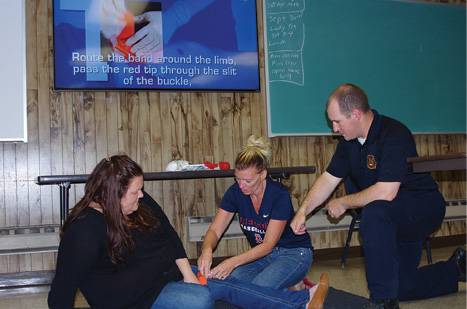
(1) A community “Stop the Bleed” program. (Photo by Bill Rohrer.)
This is one of the basic principles established by The Joint Committee to Create a National Policy to Enhance Survivability from an Intentional Mass-Casualty and Active Shooter Event. This committee, comprised of experts from the national government, law enforcement (LE), emergency response, and medical field, met initially in 2013 and made several national recommendations. The THREAT acronym was included in their recommendations as a foundation for responding to active-shooter and other intentionally caused MCIs. THREAT outlines a coordinated response from the public, LE, emergency medical services (EMS)/fire/rescue, and hospitals to minimize loss of life.
“Stop the Bleed”
“No one should die from uncontrolled hemorrhage.” This includes the whole of your community, no matter the size. This was the main focus of the Hartford Consensus’ call to action. Included is a multifaceted response to injuries caused during an intentional MCI. The consensus, along with The White House’s “Stop the Bleed” program, calls for the uninjured public to provide the first line of care. This concept works off a person’s inherent will to help others in emergency situations. It also illustrates how simple tasks can mean the difference between life and death from a massive hemorrhage.
There are several options to assist in ensuring success for this layperson response. Making public access bleeding control kits available in public buildings and community education are the first steps. Much as automated external defibrillators (AEDs) are now common in almost all public spaces to combat sudden cardiac arrest, public access bleeding control kits can be placed in similar areas to allow the layperson to stop a massive hemorrhage simultaneously with calls for formal emergency response. Becoming involved with instruction or distributing these kits may strengthen relationships in the community. Teaching bleeding control with formal or hands-only cardiopulmonary resuscitation classes is a simple way to integrate this valuable lesson into required training. Schools, churches, malls, businesses, and parks are high-risk targets that can benefit greatly from being educated and outfitted.
Law Enforcement
The second link in response is trained and equipped law enforcement officers. The primary objective of law enforcement should be to subdue the offenders. This duty is paramount, and it is consistently completed in the first several minutes of an incident by first responding officers or by the offenders themselves. Since terrorist/intentional MCIs necessitate a large LE response, many officers may not be involved in direct confrontation with the offenders. This allows them to begin the setup for other essential tasks such as hemorrhage control, initiating the incident command system (ICS), and beginning rescue task force operations. Ensuring these officers are outfitted with medical equipment is important, even while the priority of LE resources remains focused on securing and subduing threats. Smaller municipalities may need to work with mutual-aid police officers from neighboring jurisdictions to ensure they are involved in the planning process and are similarly equipped. This will make certain everyone is working from the same playbook and is familiar with equipment in case it needs to be shared.
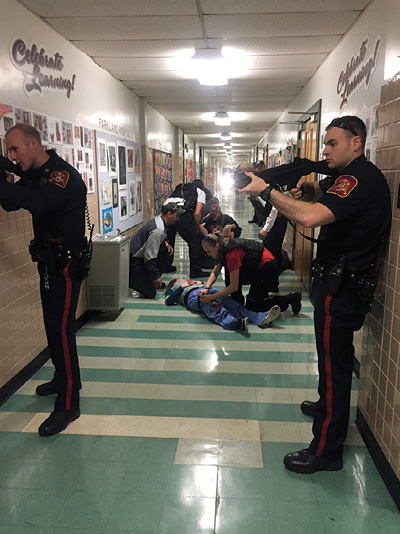
(2) Joint training with law enforcement using rescue task force concepts. (Photos 2 and 3 courtesy of authors.)
Since responding officers may be in the direct line of violence and have a higher possibility of being injured, each officer should be outfitted with an individual first aid kit (IFAK) as well. These kits allow for self or buddy care for massive hemorrhage and traumatic injuries. The kit usually contains a commercial tourniquet, hemostatic impregnated gauze, and pressure dressings, a multitude of solutions to fit any officer. Though typically reserved for the individual officer, supplies may be used on victims encountered after the immediate threat has been removed and prior to EMS/rescue contact. LE officers will also benefit from carrying an IFAK at all times because of the increasing number of violent encounters they face daily.
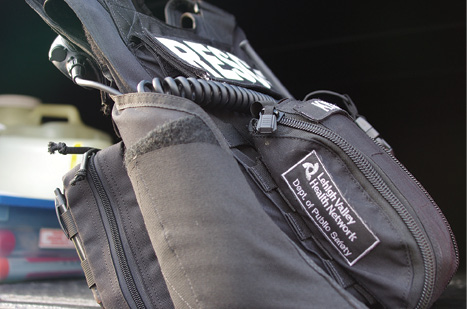
(3) An individual first aid kit provided by a local hospital through a grant.
Redefining Fire and EMS Roles: Rescue Task Force
Fire and EMS will need to redefine their actions in an intentional MCI. For years, a typical fire or EMS response to any type of violent call involved staging well outside the area until the scene was completely secured. As noted at several recent events, conflicting reports and large-scale incidents tend to take a good deal of time to completely secure, and this can lead to loss of life from a massive hemorrhage. To prevent loss of life, fire and EMS need to integrate with LE to quickly bring patient care as close to the point of injury as possible. From this, the rescue task force (RTF) concept was born.
The RTF is a group consisting of EMS/fire responders who enter a warm zone that LE has not yet cleared completely. RTF members are escorted and covered by LE officers while they rapidly treat the patient. Treatment includes placing tourniquets or adjusting the airway and evacuating the patient to a casualty collection point (CCP). Depending on the situation or the geographic size of the incident, CCPs may be set up in areas that LE has cleared; however, they still need continual force protection. At these forward locations, teams can move to more advanced care until personnel are available to evacuate patients to a cold zone CCP or treatment area.
The cold zone CCP or treatment area, once established, serves as a mustering point for fire and EMS resources. This area needs to be out of the line of sight from direct violence and may need to be a considerable distance away. All members of the emergency response, including LE, should be advised of the CCP location. LE officers should try to keep the area clear of extra vehicles to ensure appropriate ambulance routes to and from the CCP. Fire and EMS apparatus should also keep that path clear to ensure rapid transport of patients. This area may also be a good location for the operational section of the ICS system. This would allow for operational control and accountability for linking RTF personnel moving forward while other RTF teams move to evacuate patients to CCPs. The formal unified command post should be well in the cold zone area. Both areas should have LE for security protection.
Transport to a hospital and definitive care is the last link in the chain to “Stop the Bleed.” For patients with internal injuries or uncontrollable bleeding, this is paramount. They must be the first patients transported to surgically equipped trauma centers. Transport should be as organized as possible so as not to delay care; however, using nontraditional transport techniques (i.e., police cars and pickup trucks, for example) can bring another level of chaos to the event. Having a transport plan in place prior to the incident can help quell inappropriate transport and lack of coordination that result in overwhelming hospitals. Ensuring that all responders are aware of the capabilities of local hospitals is a good start. Many LE officers do not have consistent exposure to or a complete understanding of hospital capabilities. Fire/rescue/EMS must work to appropriately triage patients and assign them to the hospital that meets their needs. If a patient’s bleeding has stopped with tourniquet application, he may not immediately need surgical intervention. As the TECC guidelines show, tourniquets can remain in place for several hours. This allows patients to be transported to hospitals with lower levels of trauma care for stabilization prior to surgical intervention.
What is also paramount is having all of your local hospitals on the same page and ready to accept patients prior to an incident’s occurring. One way to do this is to include them in drills or training. It is a Joint Commission requirement for hospitals to hold emergency disaster drills; this may be a simple way to include them in planning and training. Many health systems have high-profile buildings or campuses that can serve as a drill area to get all of the responders in one place and show the importance of training to the public.
Educational Offerings
An increasing number of educational offerings are available nationwide. The National Association of Emergency Medical Technicians offers tiered training that follows the most current recommendations. For the lay responder, teachers, and community members, the Bleeding Control for the Injured class may be appropriate. This is an entry-level class that illustrates the importance of public access to bleeding control and how to intervene with direct pressure, tourniquets, and pressure bandages in patients with massive hemorrhaging.
The Law Enforcement and First Response (LEFR) Tactical Care class is an excellent introductory class for LE officers and fire/rescue members with limited previous medical training. The components of the course include instruction regarding RTF operations, hemorrhage control, simple airway management, and patient evacuation.
Tactical Emergency Casualty Care is a civilian adapted version of the military focused Tactical Combat Casualty Care. This should serve as the standard for all EMS providers, both basic and advanced life support. This course builds on LEFR with advanced airway techniques, medication administration, needle thoracostomy, and treating wounded responders.
For the RTF to work, agencies need to build relationships so all members of the team understand how the other members work and think. Once medical training has been accomplished by all members, LE should train with fire/EMS on tactical movement and close-quarters drills. One example may be including fire/EMS providers on simple room-clearing exercises with LE, slowly adding RTF components. Medical care, fire suppression, and incident command may not be strong suits for LE; however, tactical movement and force protection are. Ensuring that teams have strong working relationships in training will solidify response to a worst-case scenario.
For a truly integrated and comprehensive response, all of these levels of training need to be implemented. As has been proven many times, a chain is only as strong as its weakest link. Instructing the public, training LE officers, updating continuing education for firefighters/EMS providers, and drilling with hospitals will ensure that no patient dies unnecessarily from a massive hemorrhage. Being a leader in terrorism and intentional MCIs means being prepared well before an event occurs. Research what other municipalities are doing and how they respond to these events. This is key to finding a solid starting block and avoiding errors other departments have experienced. There is a mountain of information available on how to respond; use that to your benefit. Educating and involving all members in the preparations will ensure that the community is successful in defending itself from one of these heinous events.
Putting It All Together
The goal in an intentional MCI is to have everyone in your community work together as efficiently as possible. This can take some time to accomplish; however, it is imperative that all branches of the emergency response are successful.
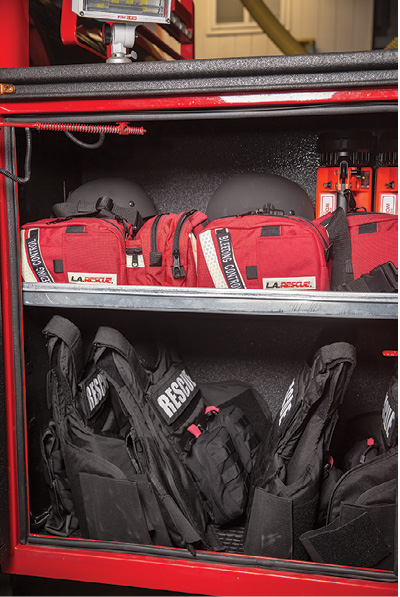
(4) An active assailant compartment. (Photo courtesy of authors.)
As we all know, with many type “A” personalities in one room, sometimes it can be challenging to come up with a single plan with the common goal in mind. There frequently are conflicts because of a lack of understanding on what the fire department can bring to the table. This may be especially prevalent when it comes to the volunteer fire service. It is our job to market our abilities and demonstrate how valuable we can be outside of normal fire suppression duties.
In the eastern Pennsylvania region, most fire departments are separate from EMS, but many firefighters have virtually the same medical training as those who work in EMS. MCIs are personnel-intensive operations, and the use of fire department personnel can alleviate some of that burden. One thing that has been noted while doing drills to solidify our response plan in this area is that medically trained firefighters are good at rapid assessment and initial triage, in addition to lifting and moving patients.
On the same note, our EMS agencies are proficient and practiced in traditional MCI operations including advanced triage, treatment areas, and transportation duties. Use your strengths to your advantage. If possible, and if there are enough personnel on the scene, limit the RTF entry team to firefighters who are medically trained, and allow EMS to run the cold zone triage, treatment, and transport operations.
Educating the members of your department on warm zone care and RTF operations is essential to decrease apprehension. Take the time to explain concepts to all members of your department, even if they will not be serving on the RTFs. This will help decrease “idle engine house chatter” that can be detrimental in changing mindsets. For years, we have drilled into the heads of new firefighters that staging is important for violent encounters and we cannot enter the area until it is clear. Changing these habits of operation will not be easy; however, instructing your members using facts will go a long way to get buy-in from them.
The LE branch of the response should be concentrated on neutralizing the threats and providing force protection as part of the RTF. Once the suspect is neutralized, officers should provide care to those wounded around them. Once RTF personnel arrive, the officers should resume force protection, including additional clearing of the area, supporting RTF teams, and searching for other subjects.
Equipment. Standardize equipment across the branches of response groups to increase members’ familiarity with equipment. This is extremely important if your response will involve mutual-aid departments. Equipment should be regulated to ensure familiarity and interoperability among responders. Apply this concept also if your response is dependent on an uncertain number of volunteers. If equipment is universal among responders, it can be shared with the appropriate available personnel on the scene. Again, the largest obstacle to success is not understanding the capabilities of other groups. A properly coordinated response should be well-rounded and capitalize on the strengths of each branch.
Communication. Communication is yet another component of response that needs to be flawless. Including 911 dispatchers in planning will help them prepare for the rapid influx of emergency communications during these events. They will be required to field calls for help, dispatch the appropriate resources, and organize the needs of all the facets of response. Establishing a strong unified command structure is one way to mitigate problems with communications in the 911 center and on the scene. Depending on your system, each branch of the response may have different radios or frequencies. This can help and hinder. Communications are frequently missed between the LE and fire/EMS/rescue assets because of different radio systems. Having commanders from each branch in one location with direct communication and oversight of their respective branch may alleviate some confusion. Since these events are primarily LE driven, officers should remain in command; however, each branch should be represented and supported to create a truly coordinated response.
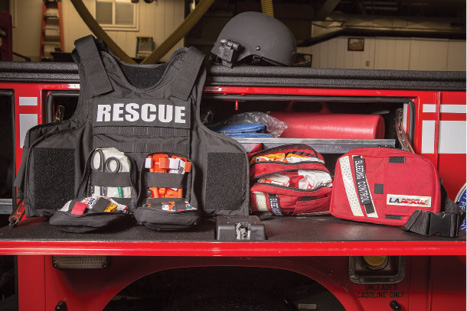
(5) Standardized equipment through the departments. (Photo courtesy of authors.)
The attacks on 9/11 taught us that we need to streamline communication access and use the National Incident Management System when commanding an incident; however, 17 years later, some of us are still fighting the same problems. Command, control, and communication are the most important parts of any response; they must be key components in your plan.
One item that cannot be emphasized enough is that all agencies need to be on the same page and relationships among the agencies need to be strong. Consistently training together and developing a social bond will ensure that the worst incident of your careers won’t be the first time you are all working together.
Funding the Response
All branches of emergency services across the country are facing tight budgets, and small towns are no different. Funding for needed equipment may be an enormous challenge for these low-frequency/high-impact events. Creative funding ideas may be needed to ready your team.
Luckily, many organizations and the local and federal governments have been very supportive in obtaining and purchasing equipment. Grants to ready your organization are available through many public and private sources. Remember to consider that many ballistic vests and some medical equipment have expiration dates, requiring a consistent funding stream to maintain a state of readiness.
If obtaining equipment is difficult, you may have to find creative solutions. Purchasing items that can be used in multiple types of situations may be one solution. A soft webbing litter traditionally used for bariatric emergencies may be used for rapid evacuation at a terrorist incident or during fireground rapid intervention team operations. Bleeding-control equipment can be used on many types of traumatic injuries not caused by a terroristic act. This can include motor vehicle accidents, technical rescue, power equipment injuries, and self-inflicted harm. Having and using this equipment on a regular basis will make it second nature to use in an intentional MCI.
Partnering with organizations may be another solution to funding. Having purchasing power in larger numbers can drive down costs, and government pricing may be available to different organizations. One example is purchasing personal protective equipment for LE officers that can be used by fire/EMS personnel. Their roles may be different on the scene, but there is often equipment that can be universal among responders. Since ballistic protection is recommended for all responders, purchasing the same items for police officers and rescue teams may make the equipment cheaper, more universal, and more available in a time of need. Decision makers are likely to be more receptive if you have an organized list of needs as part of your unified group plan; this includes a plan coordinating response and equipment use throughout all of the response branches.
Another example of partnership may be health care organizations providing equipment to public safety responders. Hospital purchasing power or trusts may be used to purchase IFAKs to outfit LE or medical equipment for fire/EMS. Having the appropriate equipment in the hands of trained providers will save lives. This will also bring care as close to the point of injury as possible. If hemorrhage does not become massive, that can drastically change a hospital admission. Decreasing mortality, shortening length of stay, and having fewer complications are all hospital goals that could be improved before the patient enters the hospital.
With the increasing prevalence of intentional MCIs, no community is immune. Preparing is a must. Do your research and observe how other departments are preparing. As we have seen with recent incidents, all eyes are on the responders, and responses to these incidents have to be integrated and coordinated. Review how other departments responded to incidents and learn from the positives and negatives of those responses. All of your community stakeholders must be involved and discuss all of the possible solutions for your area. This will take time and will not happen overnight. In the long run, a strong coordinated response prepared for the worst will be priceless. Ensure your equipment is standardized and the response plan is being drilled on regularly. Engage the public and health care institutions. We are all here for the same fight: to care for each other no matter what the cost.
James Kutz is a 22-year veteran of the fire service and the chief of the Woodlawn Fire Department in South Whitehall Township, Pennsylvania. He is also a career firefighter for Allentown, Pennsylvania, where he has served for 16 years and has the rank of captain. He has an associate degree in fire science and a bachelor’s degree in fire administration, both from Columbia Southern University. He is a hazardous device technician on the Allentown Bomb Squad and a suppression instructor for the Commonwealth of Pennsylvania and the Allentown Fire Academy.
James Kish is a deputy chief at the Woodlawn Fire Department in South Whitehall Township, Pennsylvania, where he has served as a volunteer since 2004. He is also a prehospital registered nurse and trustee with Cetronia Ambulance Corps in Allentown, Pennsylvania. He is employed by Lehigh Valley Health Network-MedEvac as a critical care transport nurse serving Eastern Pennsylvania. He received his B.S. degree in nursing from DeSales University in 2009. He is an NAEMT instructor, certified in emergency and flight nursing by the Board of Certification of Emergency Nurses.

